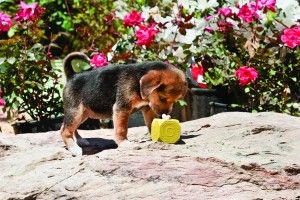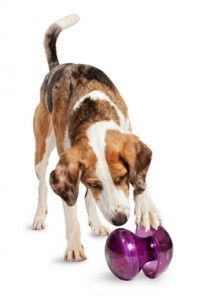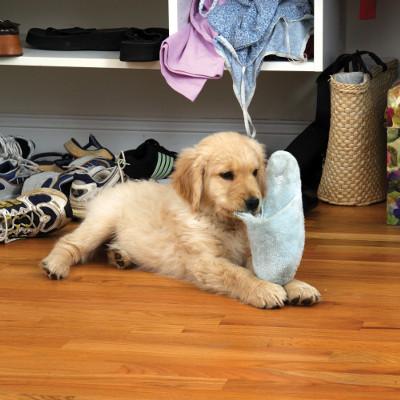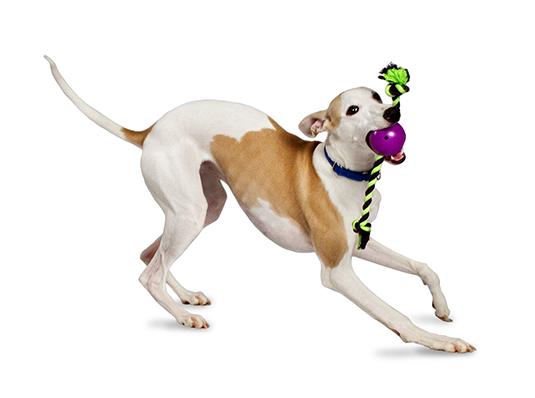by Michelle Mullins
Dogs of all ages need to chew. Chewing is an instinctual behavior and occurs for a variety of reasons. Chewing in young dogs can be prompted by teething and continue as an exploratory behavior as dogs simply check new things out with their mouths. Despite chewing being a normal behavior for dogs it is a very serious problem when the dog is chewing inappropriate items such as books, shoes and TV remotes. It is also dangerous for your dog if he chews and even ingests things that could cause poisoning, intestinal blockage or other injury.
Excessive chewing or eating of non-food items could be a serious medical issue and you should consult with your veterinarian. There are many ways to help your dog to safely fulfill his need to chew and not allow the destruction of your possessions.
Provide appropriate items for your dog to chew. Toys, especially food/treat dispensing and puzzle toys are great to keep dogs busy and appropriately engaged for extended times. They can be used to feed the dog’s regular daily portion of food instead of high calorie treats and keep dogs from scarfing their food from a bowl. The act of chasing down or foraging for a meal and eating it is much more enriching than having a cup of kibble just dumped in a bowl. This makes puzzle toys and feeders a great addition to your pet’s mealtime. Having to work a bit to gain a meal also promotes activity, which our pets often don’t get enough of, can aid in weight loss and can help prevent chewing due to inactivity. They also help to keep them thinking and learning, which promotes better cognitive health.
While you can certainly add a few pungent, extra tasty treats to the toys, keep those to a minimum as an addition to their regular meal.  All dogs interact with chew toys differently so finding the right toys for your dog is important. Some great examples of interactive toys are in our Busy Buddy line. You will want to find a variety of toys for your dog so you can rotate them and keep your dog interested and challenged. Supervise your dog with all new toys.
All dogs interact with chew toys differently so finding the right toys for your dog is important. Some great examples of interactive toys are in our Busy Buddy line. You will want to find a variety of toys for your dog so you can rotate them and keep your dog interested and challenged. Supervise your dog with all new toys.
Choosing the toys depends on many factors and seems confusing with all the choices out there.
Consider the age of your dog. Puppies should be introduced to toys as early as possible but they don’t even have teeth until three to six weeks of age. So puppies need softer toys to protect gums and baby teeth. Consider dog safe plush toys and puppy lines at this stage.
Our Busy Buddy Puppy line is a great choice.  Dogs have their adult teeth by about six to seven months, having started to lose baby teeth around four months. This teething period can be difficult and you will want to have lots of appropriate chew toys on hand to avoid having your dog chew up your favorite shoes.
Dogs have their adult teeth by about six to seven months, having started to lose baby teeth around four months. This teething period can be difficult and you will want to have lots of appropriate chew toys on hand to avoid having your dog chew up your favorite shoes.
Safe chew toys can help keep a dog’s teeth healthy throughout their lifetime. Even so older dogs can develop issues with their teeth and gums just like us humans, due to tooth decay and wear and tear. These dogs often still enjoy chomping on a good chew toy but may need a softer toy.
Consider the size of your dog. Generally, the larger the dog the larger the toy. Consider too the type of muzzle your dog has. For example Greyhounds and Labradors can fall into the same weight range but a greyhound’s muzzle is much slighter than a labrador’s thick muzzle. If you just aren’t sure which size will be safe for your dog, go up a size.
Observe your dog’s play and chew style. Some dogs love to get the toy down, hold it between their paws and chew with all their might. Others prefer to toss the toy around, flip it in the air, bounce it down the hall and then settle in for some light mouthing. And of course others do everything in between.
How your dog likes to interact with toys will help you decide on whether to purchase the toughest toys on the market or the softer chew your dog may prefer.
When purchasing a toy consider everything you know about your dog, read the labels carefully and adhere to safety recommendations. Follow the guidelines on the packaging about weight, breed and chew strength to choose the best one for your pup. Read any accompanying instructions and save the package for a while in case you need to call the company with questions.
Now that you know what your dog may like here are some tips on what to look for in a good chew toy.
Consider materials. Natural rubber chew toys are a good choice for most dogs. Not all rubber is the same however, so some hold up better than others to chewing. The thickness of the rubber matters as well.  Nylon can be a good choice for some dogs and is very durable especially for those dogs who destroy every toy.
Nylon can be a good choice for some dogs and is very durable especially for those dogs who destroy every toy.
Other toys including plush toys and softer items can be great but you should supervise your dog with these as they are easy to destroy and ingest. No dog toy is indestructible! If they were truly indestructible they would probably be way too hard and could damage a dog’s teeth.
A toy may be extremely durable, but always supervise your dog with the toy to determine how it holds up to your dog. If the toy becomes damaged replace it with a new toy. I know we want these toys to last forever but dog’s teeth are designed to rip, tear and crush. The best you can do is provide appropriate things for this fun activity and replace them when necessary!
Don’t be afraid to ask. Pet professionals are always testing out new chew toys. So ask your veterinarian, veterinary technician or trainer.
Manage the environment. Dogs need time to develop appropriate chewing habits. Keep as many items as possible out of reach so your dog doesn’t have the opportunity to chew them. Keep trash cans in cupboards, pantries and in closed rooms. Pick up shoes, papers, mobile phones and put them in safe locations. Confine your dog to a crate or puppy-proof room when unsupervised. You may consider the use of untasty deterrents to spray on items that should not be chewed. These can be effective but some dogs chew the items anyway.
Teach your dog to make good chewing choices. In addition to providing appropriate chew toys you can also help your dog learn to make good decisions about what to chew. Rewarding him with praise and attention when he is chewing on these can encourage him to continue to choose the toys. You can also redirect him from a bad choice such as nibbling the chair leg or trotting by with your slipper by encouraging him to play with you and offering him a food dispensing toy as an alternative. 




